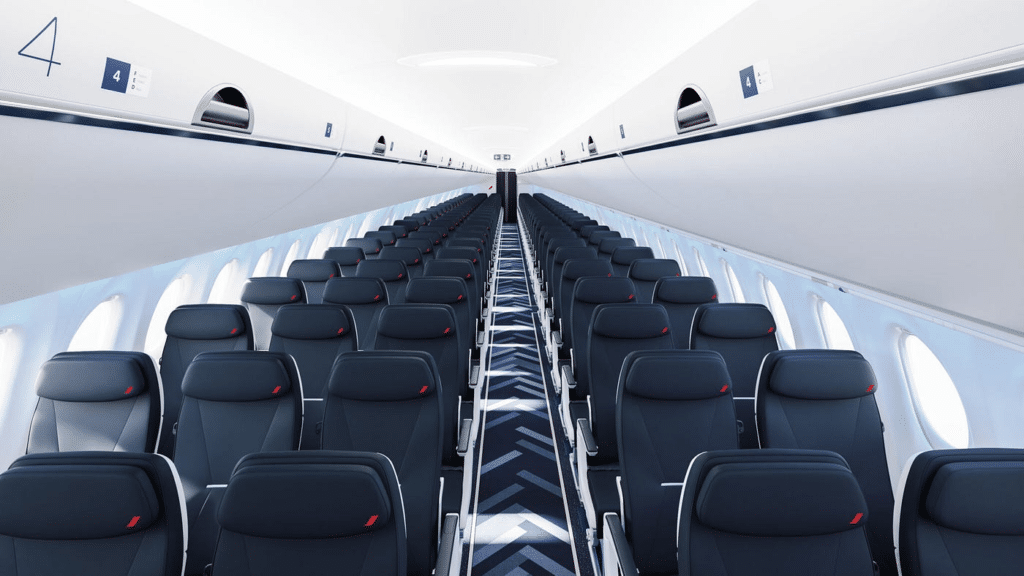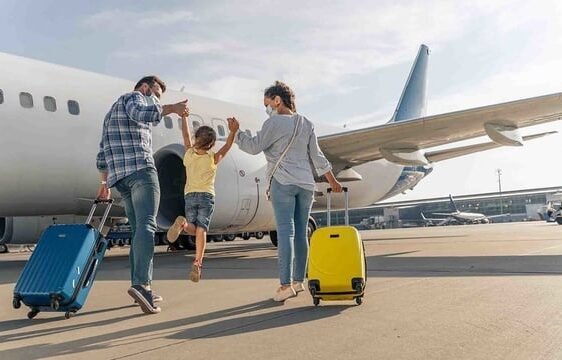Traveling by air can be an exhilarating experience that opens up endless possibilities for adventure. Whether you’re embarking on a long-haul international journey or a quick domestic flight, the flying experience can greatly influence the rest of your trip. However, as much as air travel has revolutionized the way we explore the world, it also comes with its own set of challenges. From long security lines to potential flight delays, it’s important to know how to navigate the skies with ease. In this article, we’ll explore tips, insights, and advice for a smooth and stress-free travel flight experience, ensuring that you arrive at your destination relaxed and ready to embark on your journey.
1. Planning and Preparation

The first step toward a smooth flight experience starts long before you even board the plane. Good planning and preparation can help you avoid common travel headaches and make your journey more comfortable.
Booking the Right Flight
Choosing the right flight can have a significant impact on your overall experience. When booking your flight, consider the following:
- Flight Times: Opt for flights that align with your natural rhythm. If you’re not a morning person, avoid early-morning flights. If you’re more comfortable flying at night, consider a red-eye flight.
- Layovers: For long-haul flights, consider how long your layover is. Longer layovers may give you a chance to rest, stretch, and grab a bite to eat. On the other hand, a quick layover can reduce your chances of missing connecting flights.
- Flight Routes: Non-stop flights are generally the easiest and most efficient way to reach your destination. Direct flights minimize the risk of missed connections and provide less stress.
Packing Smart
Packing efficiently for your flight can make a big difference in your comfort level during travel. Here are some packing tips to ensure a smoother experience:
- Carry-On Essentials: In your carry-on bag, include travel essentials like your passport, boarding pass, medications, a water bottle, and any valuable items. Having these things within reach will save you time and energy.
- Clothing Layers: Airplane cabins can vary in temperature. Wear layers that you can adjust for comfort—add or remove clothing as necessary.
- Snacks and Entertainment: Stock up on snacks that are both healthy and easy to eat. Bring a book, magazine, or download movies and music to stay entertained during the flight.
Check-in and Security
- Online Check-In: To avoid long lines, check-in online before your flight. Many airlines allow you to check in up to 24 hours before departure, making the process quick and easy. If you’re traveling with only a carry-on bag, you can often head straight to security.
- Know Security Regulations: Be familiar with TSA regulations for carry-on items, including liquid restrictions. Pack your liquids in a clear, resealable bag and ensure they meet the volume requirements.
2. At the Airport

Arriving at the airport prepared is key to a smooth and stress-free flying experience. Here are some tips for navigating the airport with ease:
Arrive Early
Airports can be busy, especially during peak travel seasons. Arriving at least 2 hours before a domestic flight and 3 hours before an international flight will give you ample time to check-in, go through security, and find your gate.
Know Your Gate and Boarding Time
Once you’ve checked in, find your gate as soon as possible and familiarize yourself with any potential changes to boarding time. Monitor the flight information screens for any delays or gate changes.
Airport Amenities
Many airports offer amenities such as lounges, charging stations, free Wi-Fi, and food courts. Take advantage of these to relax, recharge, and prepare for your flight. If you’re flying internationally, you might also want to explore duty-free shops or local offerings.
3. On the Plane

Now that you’ve made it through security and are seated on your flight, there are still ways to ensure that your journey is as comfortable as possible.
Choose the Right Seat
Selecting a seat that suits your preferences is one of the simplest ways to improve your flight experience. Here are some considerations:
- Window or Aisle: If you enjoy the view or prefer to rest against the wall, go for the window seat. If you prefer easy access to the aisle or need to stretch your legs, the aisle seat is the best option.
- Exit Rows: Exit row seats offer more legroom but may have certain restrictions (such as not being able to recline the seat).
- Bulkhead Seats: These seats, located at the front of each cabin section, often offer more space but might be close to bathrooms or high-traffic areas.
Stay Hydrated and Comfortable
The cabin air on planes is often dry, so be sure to drink plenty of water to stay hydrated throughout your flight. Avoid too much caffeine or alcohol, as these can dehydrate you.
Move Around
Long flights can lead to stiff joints and fatigue. Periodically stretch your legs, walk around the cabin, or perform seated stretches to improve circulation and avoid deep vein thrombosis (DVT).
Entertainment and Relaxation
Whether you’re watching a movie, reading a book, or simply enjoying the view, find a way to entertain yourself and make the time go by faster. Noise-canceling headphones and neck pillows can also improve your comfort during the flight.
4. Handling In-Flight Issues

While air travel is generally safe and efficient, sometimes things don’t go as planned. Here are some common in-flight issues and how to handle them:
Turbulence
Turbulence is a common part of flying and can be unsettling for passengers. If you experience turbulence, remain calm and follow the seatbelt sign instructions. Don’t be afraid to ask flight attendants for reassurance or tips on staying comfortable.
Flight Delays or Cancellations
Flight delays and cancellations are often beyond your control, but how you respond can make a big difference. Stay informed by checking the flight status, and don’t hesitate to ask the airline for information about alternate arrangements. If your delay is lengthy, the airline may offer meal vouchers or hotel accommodations.
In-Flight Illness
If you or a fellow passenger feels unwell during the flight, notify the flight attendants immediately. They are trained to handle medical emergencies and can provide assistance.
5. Arrival and Post-Flight Tips

The end of your flight is just the beginning of your journey. Here are some tips for a smooth arrival:
Customs and Immigration
For international flights, you’ll need to go through customs and immigration after you land. Have your passport and any necessary documents ready. Follow signs and instructions carefully to avoid delays.
Baggage Claim
If you checked in luggage, head to the baggage claim area. If your luggage doesn’t appear, report it to the airline immediately. Make sure to file a claim for any lost or damaged luggage.
Transportation
Once you’ve cleared customs, figure out how you’ll get to your next destination. Many airports offer taxis, ride-sharing services, and shuttle buses. If you’re traveling to a hotel, some offer airport transfer services.
6. Preparing for Security and Immigration

Airport security and immigration can often be the most time-consuming and stressful part of air travel. However, with a little preparation, you can speed through these processes.
- TSA PreCheck or Global Entry: If you travel frequently, enrolling in TSA PreCheck (for domestic flights) or Global Entry (for international travel) can make a significant difference. These programs allow you to bypass long security lines and keep your shoes and belt on, making the process much quicker.
- Be Organized: To ensure a smooth security check, keep your documents, boarding pass, and identification in an easily accessible place. Be prepared to remove your laptop, liquids, and jacket, and place them in the designated bins.
- Know the Rules for Electronics and Gadgets: Some international destinations may have stricter regulations regarding electronics. It’s always a good idea to familiarize yourself with the requirements for the specific country you’re visiting to avoid unnecessary delays.
7. Handling Long-Haul Flights and Jet Lag

Long-haul flights can be exhausting and challenging, especially when crossing multiple time zones. To make your journey more comfortable and to manage jet lag:
- Adjust Your Sleep Schedule Beforehand: Gradually shift your sleeping hours a few days before departure to align with the time zone of your destination. This will help you adapt more easily upon arrival.
- Stretch and Walk Around: On long flights, try to get up every 2–3 hours to stretch your legs and prevent blood clots. Simple seated exercises can also help alleviate stiffness.
- Use Sleep Aids Wisely: If you struggle with sleep on long flights, consult your doctor about using sleep aids. Some people find that melatonin, a natural sleep hormone, can help them sleep on a plane.
8. Managing Your Travel Budget

Traveling by air can sometimes be expensive, but with careful planning, you can manage your travel budget more effectively:
- Look for Deals: Take advantage of discount travel sites, deal alerts, and airline promotions to find affordable fares. Booking in advance can also help you save money, but watch for last-minute deals when airlines need to fill seats.
- Consider Alternative Airports: Many cities have multiple airports. If you’re open to it, flying in or out of a smaller airport may save you money in both flight costs and parking fees.
- Be Mindful of Baggage Fees: Many airlines charge fees for checked bags. To avoid this, pack efficiently and try to stick to carry-on luggage. If you must check a bag, pay attention to weight limits to avoid excess baggage charges.
9. Traveling with Children

Flying with children can present its own set of challenges, but with the right approach, you can make the journey smoother for everyone:
- Pack Essentials for Kids: Bring along snacks, toys, coloring books, and other distractions to keep your child entertained during the flight. Tablets or portable devices with downloaded content can also keep children occupied.
- Choose Kid-Friendly Flights: Some airlines offer priority boarding for families with young children, which can be helpful when trying to settle in. Additionally, consider flying during nap time to help your child sleep through the flight.
- Prepare for Security with Kids: At security, you’ll need to keep a close eye on your children, as they may be asked to walk through the metal detector or have their belongings checked. Preparing them ahead of time can help avoid any confusion or frustration.
10. Post-Flight Recovery and Adjustment

After a long flight, your body can feel stiff, tired, or dehydrated. Taking steps to recover and adjust will help you feel your best after landing:
- Rehydrate Immediately: After being in a dry cabin for hours, it’s important to drink plenty of water once you arrive. Dehydration can lead to fatigue and headaches, so hydrate early and often.
- Stretch and Move Around: Once you’re off the plane, take a few minutes to stretch and get your blood flowing. Gentle stretches can help alleviate any stiffness that resulted from sitting for long periods.
- Stay Active and Rest: If you’ve arrived at a new destination, try to stay active during the day to reset your body’s internal clock. If you’ve crossed several time zones, however, don’t be afraid to take a short nap or rest before fully engaging in the activities of your new destination.
11. Navigating Airport Layouts and Connecting Flights

Airports can be sprawling, and managing your time and movement within them is essential for a seamless travel experience, especially if you have a connecting flight.
- Study the Airport Layout: Before your flight, take a moment to familiarize yourself with the airport’s layout. Many airports have mobile apps that show maps, or you can find terminal maps online. This will help you navigate the space more easily and reduce stress.
- Know Your Gate and Terminal: Upon arrival, immediately check your gate and terminal. If you have a connecting flight, double-check the time and location. If your connecting flight is in another terminal, account for the time it will take to travel between terminals and pass through security again.
- Ask for Assistance: If you’re unfamiliar with the airport or concerned about making your connection, don’t hesitate to ask airport staff for assistance. Some airports offer walking guides to help you get to your gate more quickly.
12. Managing Travel Anxiety and Fear of Flying

For some, air travel comes with anxiety, whether it’s a fear of flying or general nervousness about the experience. By addressing these concerns, you can help ease your mind and make the flight more pleasant.
- Learn Relaxation Techniques: Deep breathing exercises, mindfulness, and meditation can help calm your nerves before and during your flight. These techniques can distract your mind from anxiety and reduce physical symptoms like a racing heartbeat.
- Consider Professional Help: If your fear of flying is severe, consider seeking professional advice or therapy before your trip. Cognitive Behavioral Therapy (CBT) has been shown to be effective in treating anxiety related to flying.
- Distraction and Focus: Bring along entertainment like books, music, movies, or games to keep your mind occupied during the flight. Engaging in something you enjoy can help take the focus away from your anxiety and create a more positive experience.
13. Making the Most of In-Flight Entertainment

Airlines today offer a wide variety of in-flight entertainment options, from movies and TV shows to games and music. Knowing how to take advantage of these options can make your flight more enjoyable.
- Bring Your Own Entertainment: While many airlines provide in-flight entertainment, it’s always a good idea to have backup options. Download movies, TV shows, or books on your device before your flight to ensure you have something to keep you entertained.
- Use Noise-Canceling Headphones: The noise from engines, passengers, and general cabin chatter can make it hard to enjoy entertainment. Invest in a good pair of noise-canceling headphones to immerse yourself in your chosen entertainment without distractions.
- Interactive Games and Apps: Some airlines offer interactive games and apps that allow you to participate in quizzes or games with other passengers. These can be a fun way to pass the time and engage with the airline’s entertainment system.
14. Addressing Special Travel Needs and Accessibility

For travelers with special needs, whether related to mobility, hearing, or other conditions, it’s crucial to plan ahead to ensure a smooth flight.
- Request Assistance in Advance: Most airlines offer services for passengers with special needs, including wheelchair assistance, priority boarding, or support with hearing or vision impairments. Contact your airline at least 48 hours before your flight to make these arrangements.
- Know Your Rights: Familiarize yourself with the Air Carrier Access Act (ACAA) or similar regulations in your country. These laws ensure that airlines accommodate passengers with disabilities, including offering assistance during boarding and deplaning.
- Prepare for Medications and Medical Devices: If you need to bring medication or medical devices, check with the airline about their specific policies regarding medical equipment. Always carry any medications in their original packaging and keep them in your carry-on bag to have easy access during the flight.
15. Preparing for International Flights and Customs

Traveling internationally adds a layer of complexity, especially when it comes to customs and immigration. Preparing for these steps can reduce delays and stress during your international journey.
- Research Customs Regulations: Different countries have varying customs regulations regarding what you can bring into the country. Some items, such as food or plants, may be prohibited. Check the customs website of your destination country before departure.
- Prepare Your Documents: Ensure you have all the necessary documents for international travel, including your passport, visa (if needed), and any health-related documents (such as vaccination records). Keep these documents organized and easily accessible.
- Allow Time for Immigration: International airports often have longer lines at immigration, so plan for this extra time. Once you’ve cleared immigration, check if you need to go through customs and be prepared to declare any goods as required.
Also Read: Overcoming Travel Challenges: Stories Of Resilience And Growth
Conclusion
Flying doesn’t have to be stressful if you’re well-prepared and stay proactive about your travel experience. From efficient pre-flight preparation to handling in-flight and post-flight issues, every step you take to streamline your travel will make the journey more enjoyable. Remember that air travel is a part of your larger adventure—by embracing it with confidence and awareness, you’ll set yourself up for smoother, more enjoyable flights in the future.
7 FAQs
1. What should I do to prepare for my flight before heading to the airport?
To ensure a smooth flight, make sure you check-in online, pack your bags according to the airline’s regulations, confirm your flight details, and have all necessary travel documents (e.g., passport, tickets) ready. It’s also helpful to plan your route to the airport, allowing enough time for check-in, security checks, and any potential delays.
2. How can I avoid jet lag during long-haul flights?
Jet lag can be minimized by gradually adjusting your sleep schedule a few days before departure. Drink plenty of water, avoid caffeine and alcohol, and try to sleep on the plane if you’re flying overnight. Once you arrive at your destination, try to adjust to the local time by spending time in natural light and staying active.
3. What are the best strategies for reducing flight anxiety?
To reduce flight anxiety, practice deep breathing or meditation, listen to calming music, or distract yourself with entertainment. It’s also helpful to talk with the flight crew about your anxiety so they can offer support, and consider talking to a therapist if your anxiety is more severe.
4. What should I bring in my carry-on bag for a more comfortable flight?
Essential items for a comfortable flight include noise-canceling headphones, snacks, a reusable water bottle, a neck pillow, and entertainment (e.g., a book, tablet, or magazine). It’s also a good idea to carry any medications, travel documents, a charger, and a hand sanitizer.
5. How can I deal with delays or cancellations during my flight?
In case of a delay or cancellation, stay informed by checking the airline’s app or website for updates. If you’re at the airport, go to the customer service desk for assistance. You may be able to rebook your flight or receive compensation, depending on the circumstances and airline policies.
6. How can I make my long-haul flight more comfortable?
For long-haul flights, bring comfortable clothing, stretch and walk around periodically to prevent stiffness, stay hydrated, and use eye masks or blankets for better sleep. If the airline provides in-flight entertainment, use it to stay engaged, or bring your own books, movies, or podcasts.
7. What is the best way to handle customs and immigration when traveling internationally?
To ensure a smooth experience, research your destination’s customs regulations before departure, prepare all necessary documents, and be honest when declaring items. Make sure to fill out any required forms accurately and allow extra time for immigration processing at your destination airport.




